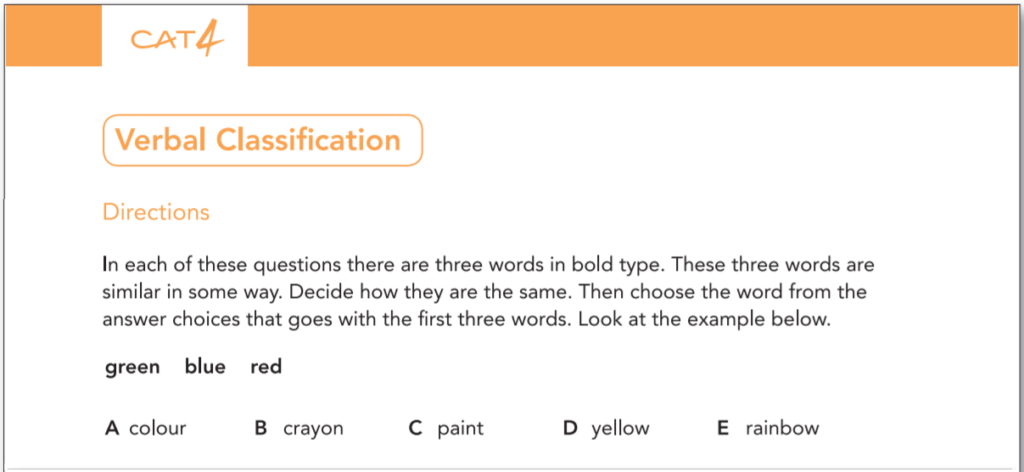The CAT4 (Cognitive Abilities Test) is often compared to IQ tests, but it is not a traditional IQ test. Instead, it is designed to measure a student’s cognitive abilities and potential in key areas such as verbal, non-verbal, quantitative, and spatial reasoning. While it shares similarities with IQ tests, the CAT4 focuses on educational development rather than providing a fixed IQ score.
This distinction is important for parents, educators, and students to understand, as it influences how the results are interpreted and used. In this article, we’ll explore what the CAT4 test is, how it differs from IQ tests, and why it’s a valuable tool in education.
What is the CAT4 Test?
The CAT4 is a widely used assessment tool in schools to evaluate students’ cognitive abilities. Developed by GL Assessment, it helps educators identify strengths, weaknesses, and learning potential. Unlike IQ tests, which focus on general intelligence, the CAT4 provides insights into specific areas of cognitive functioning.
The test is typically administered to students aged 6 to 17 and is divided into four main sections:
- Verbal Reasoning: Measures the ability to understand and reason using words.
- Non-Verbal Reasoning: Assesses problem-solving skills using shapes and patterns.
- Quantitative Reasoning: Evaluates numerical problem-solving and reasoning abilities.
- Spatial Reasoning: Tests the ability to visualize and manipulate objects in space.
Each section provides a detailed profile of the student’s abilities, helping educators tailor teaching strategies to individual needs.
How Does CAT4 Differ from an IQ Test?
While both the CAT4 and IQ tests assess cognitive abilities, they serve different purposes. IQ tests aim to measure general intelligence, often represented by a single score. In contrast, the CAT4 provides a detailed profile of a student’s abilities across multiple domains.
Key Differences Between CAT4 and IQ Tests
- Purpose:
- CAT4: Focuses on educational potential and identifying strengths and weaknesses.
- IQ Test: Measures general intelligence and provides a fixed IQ score.
- Scoring:
- CAT4: Provides multiple scores for different cognitive abilities.
- IQ Test: Offers a single IQ score, often represented as a number (e.g., 100).
- Application:
- CAT4: Used in schools for academic planning and identifying learning needs.
- IQ Test: Used in clinical and psychological settings to assess intelligence.
- Content:
- CAT4: Focuses on verbal, non-verbal, quantitative, and spatial reasoning.
- IQ Test: Covers a broader range of cognitive abilities, including memory and processing speed.
What Does the CAT4 Test Measure?
The CAT4 assesses four key areas of cognitive ability, each of which plays a crucial role in academic success.
- Verbal Reasoning: Understanding and reasoning using words.
- Non-Verbal Reasoning: Solving problems using shapes and patterns.
- Quantitative Reasoning: Working with numbers and mathematical concepts.
- Spatial Reasoning: Visualizing and manipulating objects in space.
Cognitive Abilities Assessed by CAT4
- Verbal Reasoning:
- What it measures: Vocabulary, comprehension, and verbal logic.
- Why it matters: Strong verbal reasoning skills are essential for reading, writing, and communication.
- Non-Verbal Reasoning:
- What it measures: Pattern recognition and abstract thinking.
- Why it matters: Non-verbal reasoning is critical for problem-solving and understanding complex concepts.
- Quantitative Reasoning:
- What it measures: Numerical problem-solving and reasoning.
- Why it matters: Quantitative reasoning is vital for mathematics and science subjects.
- Spatial Reasoning:
- What it measures: Visualization and spatial awareness.
- Why it matters: Spatial reasoning is important for subjects like geometry, engineering, and art.
By assessing these abilities, the CAT4 provides a comprehensive picture of a student’s cognitive strengths and areas for improvement.
Why is CAT4 Used in Schools?
The CAT4 is a valuable tool for educators for several reasons:
- Identifying Learning Needs:
- The test helps identify students who may need additional support or enrichment.
- Tailoring Teaching Strategies:
- Educators can use the results to adapt their teaching methods to suit individual learning styles.
- Predicting Academic Performance:
- The CAT4 provides insights into a student’s potential, helping schools set realistic academic goals.
- Supporting Gifted and Talented Programs:
- The test can identify students with exceptional abilities who may benefit from advanced programs.
Common Misconceptions About CAT4 and IQ Tests
There are several misconceptions about the CAT4 and its relationship to IQ tests. Let’s clarify some of the most common ones:
- Misconception 1: CAT4 is an IQ test.
- Reality: While the CAT4 measures cognitive abilities, it does not provide an IQ score.
- Misconception 2: CAT4 results determine a student’s intelligence.
- Reality: The CAT4 highlights strengths and areas for improvement, not fixed intelligence.
- Misconception 3: CAT4 is only for high-achieving students.
- Reality: The test is designed for all students, regardless of their academic performance.
How to Prepare for the CAT4 Test
While the CAT4 is not a test that can be “studied” for, there are steps students can take to prepare:
- Practice Sample Questions:
- Familiarize yourself with the format and types of questions.
- Develop Problem-Solving Skills:
- Engage in activities that require critical thinking and reasoning.
- Stay Relaxed and Focused:
- Ensure you’re well-rested and calm on the day of the test.
- Understand the Test Structure:
- Knowing what to expect can help reduce anxiety and improve performance.
Frequently Asked Questions (FAQs) About CAT4
Q1: Is CAT4 harder than an IQ test?
A: The difficulty depends on the individual’s strengths. CAT4 focuses on specific cognitive areas, while IQ tests assess general intelligence.
Q2: Can CAT4 predict academic success?
A: Yes, CAT4 results can help predict academic performance by identifying cognitive strengths and weaknesses.
Q3: Is CAT4 used outside of schools?
A: Primarily, CAT4 is used in educational settings, but it can also be used in research and talent identification programs.
Q4: How long does the CAT4 test take?
A: The test typically takes about 2 hours, divided into short sections.
Q5: Can parents access CAT4 results?
A: Yes, schools often share results with parents to discuss their child’s progress and needs.
Additional SEO Tips
- Internal Linking: Link to related pages on your site, such as “What is the CAT4 Test?” or “How to Prepare for Cognitive Ability Tests.”
- External Linking: Link to authoritative sources, such as official CAT4 documentation or educational research.
- Image Optimization: Use images like graphs or illustrations of cognitive abilities, with descriptive alt text (e.g., “CAT4 test structure and components”).
- Mobile Optimization: Ensure the page is mobile-friendly and loads quickly.
- Schema Markup: Add structured data for FAQs to enhance search visibility.





